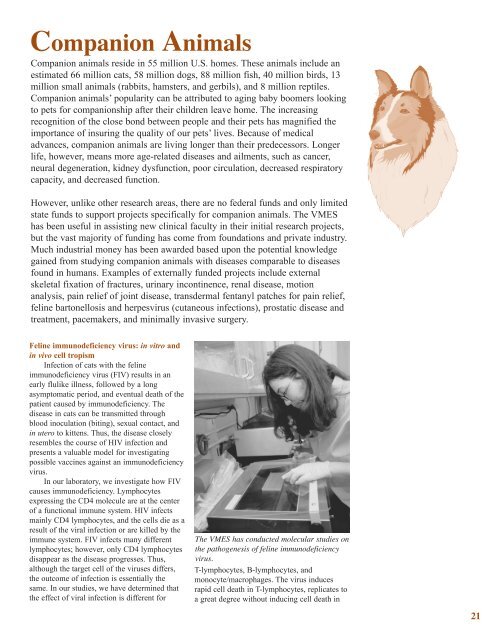Emerging Diseases - University of Georgia College of Veterinary ...
Emerging Diseases - University of Georgia College of Veterinary ...
Emerging Diseases - University of Georgia College of Veterinary ...
Create successful ePaper yourself
Turn your PDF publications into a flip-book with our unique Google optimized e-Paper software.
Companion AnimalsCompanion animals reside in 55 million U.S. homes. These animals include anestimated 66 million cats, 58 million dogs, 88 million fish, 40 million birds, 13million small animals (rabbits, hamsters, and gerbils), and 8 million reptiles.Companion animals’ popularity can be attributed to aging baby boomers lookingto pets for companionship after their children leave home. The increasingrecognition <strong>of</strong> the close bond between people and their pets has magnified theimportance <strong>of</strong> insuring the quality <strong>of</strong> our pets’ lives. Because <strong>of</strong> medicaladvances, companion animals are living longer than their predecessors. Longerlife, however, means more age-related diseases and ailments, such as cancer,neural degeneration, kidney dysfunction, poor circulation, decreased respiratorycapacity, and decreased function.However, unlike other research areas, there are no federal funds and only limitedstate funds to support projects specifically for companion animals. The VMEShas been useful in assisting new clinical faculty in their initial research projects,but the vast majority <strong>of</strong> funding has come from foundations and private industry.Much industrial money has been awarded based upon the potential knowledgegained from studying companion animals with diseases comparable to diseasesfound in humans. Examples <strong>of</strong> externally funded projects include externalskeletal fixation <strong>of</strong> fractures, urinary incontinence, renal disease, motionanalysis, pain relief <strong>of</strong> joint disease, transdermal fentanyl patches for pain relief,feline bartonellosis and herpesvirus (cutaneous infections), prostatic disease andtreatment, pacemakers, and minimally invasive surgery.Feline immunodeficiency virus: in vitro andin vivo cell tropismInfection <strong>of</strong> cats with the felineimmunodeficiency virus (FIV) results in anearly flulike illness, followed by a longasymptomatic period, and eventual death <strong>of</strong> thepatient caused by immunodeficiency. Thedisease in cats can be transmitted throughblood inoculation (biting), sexual contact, andin utero to kittens. Thus, the disease closelyresembles the course <strong>of</strong> HIV infection andpresents a valuable model for investigatingpossible vaccines against an immunodeficiencyvirus.In our laboratory, we investigate how FIVcauses immunodeficiency. Lymphocytesexpressing the CD4 molecule are at the center<strong>of</strong> a functional immune system. HIV infectsmainly CD4 lymphocytes, and the cells die as aresult <strong>of</strong> the viral infection or are killed by theimmune system. FIV infects many differentlymphocytes; however, only CD4 lymphocytesdisappear as the disease progresses. Thus,although the target cell <strong>of</strong> the viruses differs,the outcome <strong>of</strong> infection is essentially thesame. In our studies, we have determined thatthe effect <strong>of</strong> viral infection is different forThe VMES has conducted molecular studies onthe pathogenesis <strong>of</strong> feline immunodeficiencyvirus.T-lymphocytes, B-lymphocytes, andmonocyte/macrophages. The virus inducesrapid cell death in T-lymphocytes, replicates toa great degree without inducing cell death in21

















